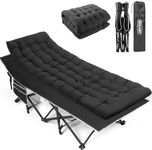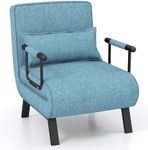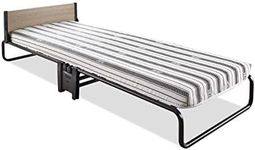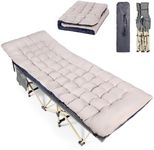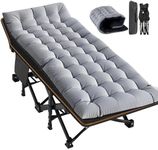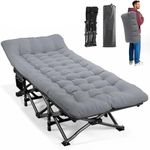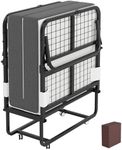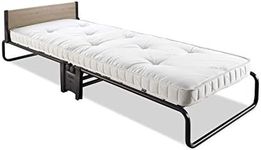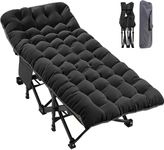Buying Guide for the Best Folding Beds
Choosing the right folding bed involves considering several factors to ensure you get a product that meets your needs for comfort, convenience, and durability. Folding beds are great for saving space and providing a quick sleeping solution for guests or small living areas. To make an informed decision, you should understand the key specifications and how they align with your requirements.SizeThe size of the folding bed is crucial as it determines how much space it will occupy when in use and how easily it can be stored. Folding beds come in various sizes, such as twin, full, and queen. If you have limited space, a twin or full-size bed might be more appropriate. However, if you need more sleeping space, a queen-size bed could be a better option. Consider the available space in your room and the comfort level you desire when choosing the size.
Mattress TypeThe mattress type affects the comfort and support of the folding bed. Common types include memory foam, innerspring, and foam mattresses. Memory foam mattresses conform to the body and provide good support, making them ideal for those who prioritize comfort. Innerspring mattresses offer a traditional feel with good support and are often more breathable. Foam mattresses are lightweight and easy to fold, making them convenient for storage. Choose a mattress type based on your comfort preference and how often the bed will be used.
Frame MaterialThe frame material impacts the durability and stability of the folding bed. Common materials include metal and wood. Metal frames are typically more durable and can support more weight, making them suitable for frequent use. Wooden frames offer a more aesthetic appeal and can be quite sturdy but may be heavier and less portable. Consider how often you will use the bed and whether you need it to be easily portable when selecting the frame material.
PortabilityPortability is important if you need to move the folding bed frequently or store it away when not in use. Features like wheels, handles, and the overall weight of the bed contribute to its portability. Lighter beds with wheels are easier to move around, making them ideal for those who need to set up and take down the bed regularly. If the bed will remain in one place most of the time, portability may be less of a concern.
Ease of SetupEase of setup refers to how quickly and effortlessly you can assemble and disassemble the folding bed. Some beds come with simple mechanisms that allow for quick setup, while others may require more effort. If you plan to use the bed frequently, look for one with a straightforward setup process to save time and hassle. Reading user reviews can provide insights into the ease of setup for different models.
Weight CapacityWeight capacity indicates the maximum weight the folding bed can support. This is important for ensuring the bed can accommodate the intended users safely. Beds with higher weight capacities are generally more robust and durable. Consider the weight of the person who will be using the bed most often and choose a bed with a suitable weight capacity to ensure safety and longevity.
Storage SpaceStorage space is a consideration if you need to store the folding bed when not in use. Some beds fold into compact sizes that can fit into closets or under other furniture. Measure the available storage space in your home and compare it with the folded dimensions of the bed to ensure it will fit. This is especially important for those living in smaller apartments or homes with limited storage options.
